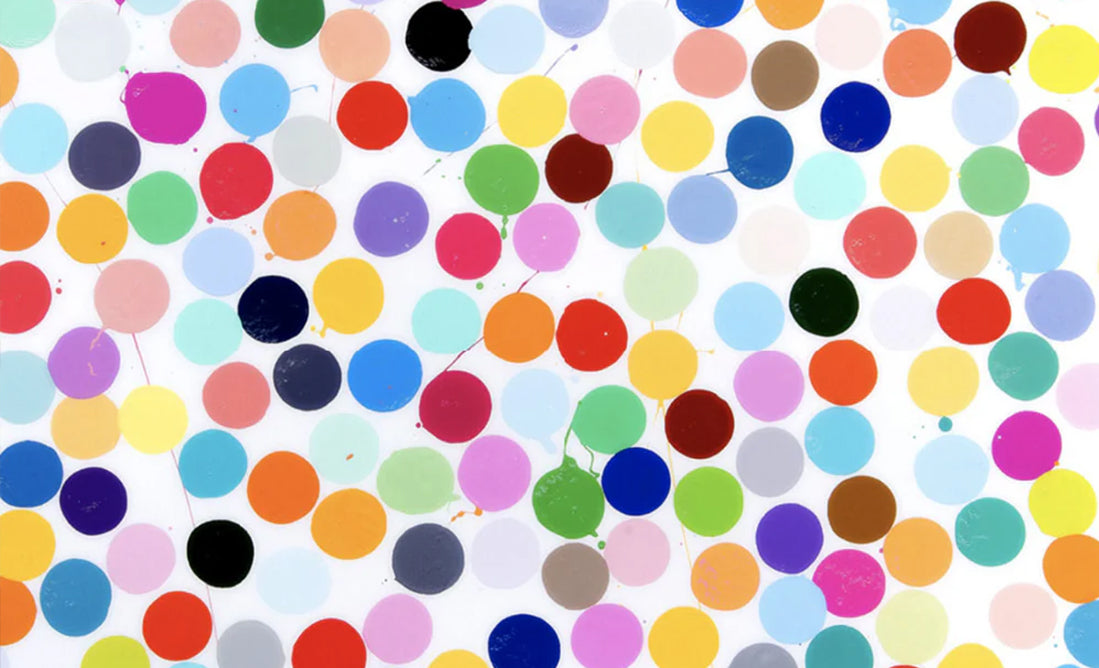Damien Hirst, one of the most provocative and influential figures in contemporary art, has continually pushed the boundaries of creativity, commerce, and concept. Among his most recognisable and enduring bodies of work is the Spot Paintings series—an exploration of colour, repetition, and industrial precision that has become synonymous with Hirst’s name. These works, sometimes dubbed "Spot Evolutions," reflect both a systematic aesthetic and an underlying commentary on the commodification and mechanisation of art.
 Damien Hirst by Prudence Cuming Associates Ltd. © Damien Hirst and Science Ltd
Damien Hirst by Prudence Cuming Associates Ltd. © Damien Hirst and Science Ltd
The Origins of the Spot Paintings
First conceived in the late 1980s, Hirst’s Spot Paintings began as an experiment in seriality and control. At a glance, these works appear deceptively simple: rows of uniformly sized, brightly coloured dots arranged on a white background. However, beneath the surface lies a rigorous conceptual framework. Hirst imposed strict rules on the creation of the spots—no colour repeats within a painting, and each spot must be precisely measured and spaced. These self-imposed limitations allowed for infinite variation within a confined structure, echoing themes of science, pharmacology, and mass production.
Art as System and Surface
The Spot Paintings mark a departure from emotional expression and a movement toward the systematic. By removing the human hand—many of the later works were executed by assistants—Hirst emphasises the idea over the gesture. The result is a series that prioritises visual uniformity and serial experimentation, often likened to scientific processes or pharmaceutical aesthetics. The clinical precision of the spots reflects Hirst’s long-standing fascination with medicine and mortality, suggesting a world where colour, control, and repetition offer comfort in the face of chaos.
Visual Impact and Interpretation
Despite their strict formalism, Hirst’s Spot Paintings engage viewers in a surprisingly visceral way. The juxtaposition of hundreds of colours within a rigid grid creates an almost hypnotic effect—both orderly and chaotic. Like Riley’s Op art, the impact of these works shifts with proximity. From a distance, the compositions resemble vibrant mosaics or digital pixels; up close, they dissolve into carefully painted circles, revealing the labor behind the illusion of simplicity. This tension between surface and substance invites contemplation of the role of the artist, the value of aesthetic experience, and the nature of mass production.
Conceptual Continuity and Expansion
Over time, the Spot series has grown to encompass hundreds of works, including variations in scale, colour density, and title. Hirst himself has acknowledged the series’ endless potential—akin to a pharmaceutical catalog or a genetic sequence, evolving without a definitive conclusion. In 2012, he famously exhibited all Spot Paintings together across 11 Gagosian galleries worldwide, a testament to the sheer scope and ambition of the project. This global exhibition highlighted not only the visual diversity within the series but also its conceptual depth and market significance.
The Currency - I Am Going Nowhere, 2021
Legacy and Dialogue
Damien Hirst’s Spot Paintings have sparked both admiration and critique, embodying many of the paradoxes that define his career. They are simultaneously formulaic and beautiful, impersonal yet deeply conceptual. For some, they represent the commodification of art in the age of global capitalism; for others, they are meditative explorations of pattern and colour. Regardless of interpretation, their impact is undeniable. They challenge the viewer to reconsider what art can be—how it’s made, by whom, and to what end.
Conclusion
In conclusion, Damien Hirst’s Spot Paintings, or “Spot Evolutions,” stand as a landmark achievement in contemporary conceptual art. By reducing painting to a system of repetition and colour, Hirst not only redefines the role of the artist but also interrogates the relationship between aesthetics, science, and commerce. The enduring appeal of the Spot series lies in its ability to be both visually arresting and intellectually provocative—a testament to Hirst’s vision and his ongoing evolution as an artist. Through these seemingly simple dots, Hirst invites us into a deeper conversation about art, meaning, and the structures that shape our perception.






Leave a comment
This site is protected by hCaptcha and the hCaptcha Privacy Policy and Terms of Service apply.